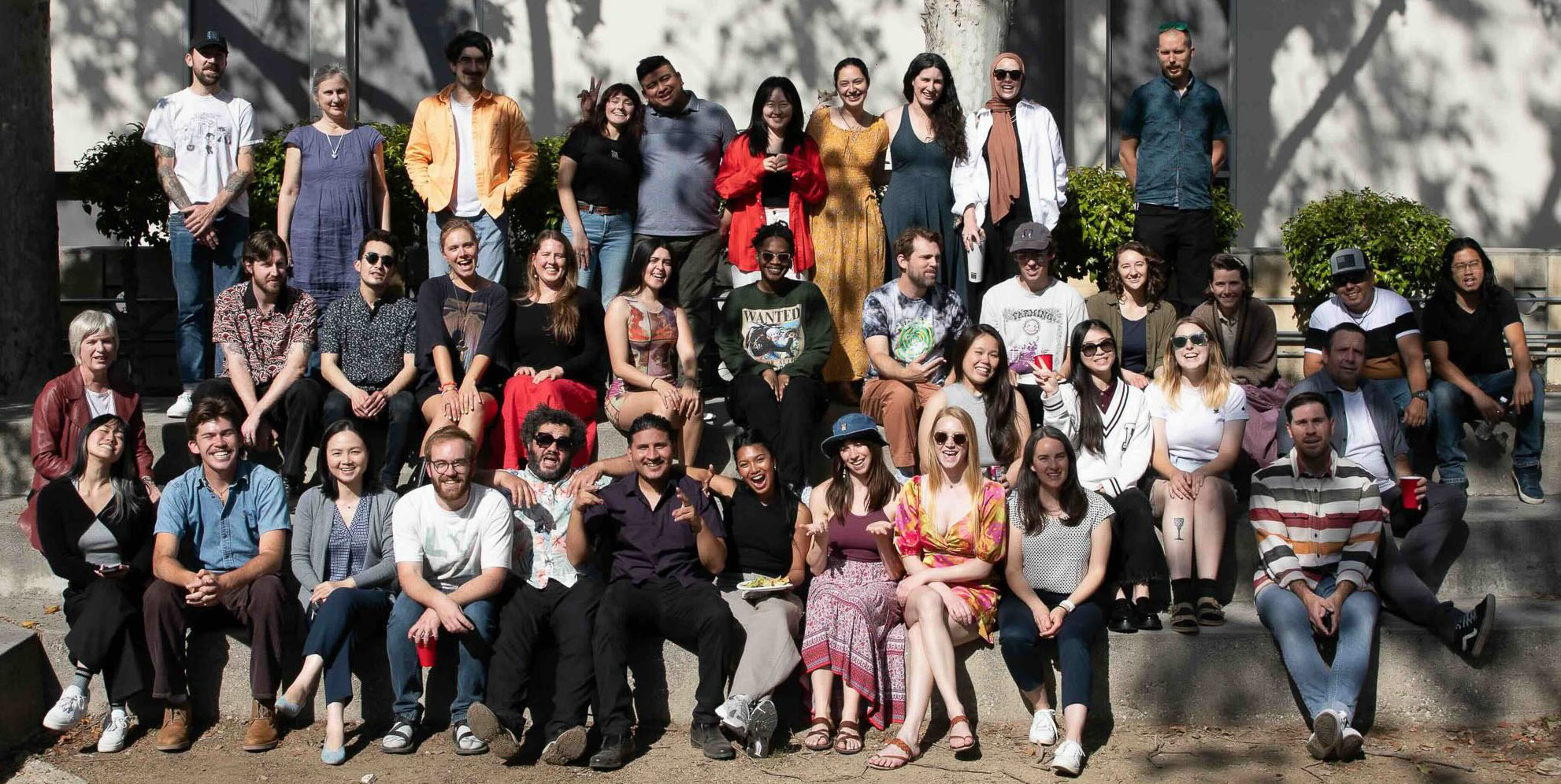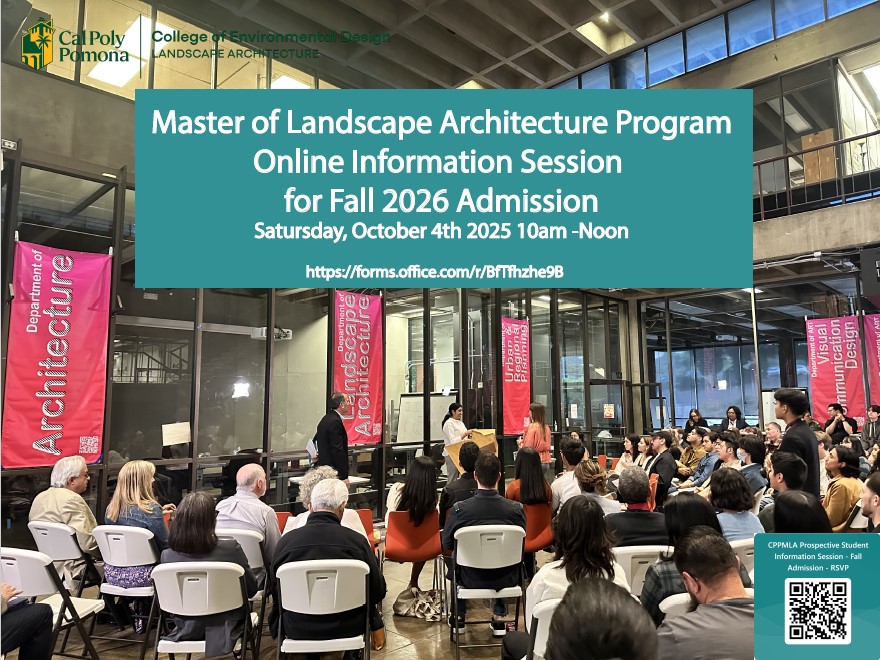Master of Landscape Architecture

Cal Poly Pomona MLA Program Faculty and Student Gathering - 2023
The MLA program welcome applicants from highly diverse academic and socioeconomic backgrounds. Our program offers students the opportunity to develop leadership, contemporary knowledge, advanced skills, and practical experience in evidence-based landscape architecture. Out curriculum stresses academic excellence focused on developing awareness of current issues and opportunities, experimenting with innovative methods and technologies to develop solutions, and synthesizing interdisciplinary knowledge, community-based knowledge, connecting personal values to analyses, policies, and designs at multiple scales. We use evidence that support the planning and design process, derived from academic research literature, community engagement, and the wealth of accessible data to inform decision-making and design.
We invite you to take the next step by signing up for one of our upcoming Information Sessions, currently arranged on Saturday, October 4th, where you’ll meet faculty, explore the curriculum, and get answers to your questions about the application process. We look forward to welcoming you to our community!
Email mla@cpp.edu for access to the recording of the information session if you miss the Zoom meeting.

Overview
California State Polytechnic University, Pomona is the only public university in Southern California offering a Master of Landscape Architecture (MLA) degree. Established in 1972 by John T. Lyle, our fully-accredited program has a rich history of developing professionals who move into leadership positions in public, private and non-profit sectors.
The CPP Master of Landscape Architecture (M.L.A.) program prepares students to solve emerging environmental and social issues of the 21st century by instilling advanced theoretical, methodological, and technical knowledge of landscape architecture, developing creative and critical thinking skills, and establishing strong, well-defined, and mutually life-sustaining relationships between people and the land.
Fully accredited by Landscape Architectural Accreditation Board (LAAB) (MLA: LR Spring 2023/NR Spring 2029), CPP M.L.A. is an exceptional program of academic excellence. It is nationally recognized for applying advanced research methods and creative approaches toward professional landscape architecture practice. The program prepares students to be socially proactive, environmentally responsible, theoretically sophisticated, and technically robust, thus becoming both scientifically rational and curiously critical in making decisions to protect and improve our society's environmental and social aspects. Upon graduation, they are prepared to solve complicated environmental and social problems and enhance social and ecological sustainability with professional integrity.
Our LAAB accredited Master of Landscape Architecture (MLA) curriculum (see below) emphasizes evidence-based landscape architecture practice and collaborative learn-by-doing assignments at scales varying from small sites to large complex regions, with a focus on projects that address critical environmental and social issues. Faculty and students in the program closely collaborate with public agencies from federal to local levels and engage various stakeholders, especially those from disadvantaged and underserved communities. Our studio culture embraces collaboration as a means of enabling every student to excel based on their individual abilities, interests, and values. Our graduate studios are next to each other in the Boltz Courtyard of Building 2, the cultural heart of our BSLA and MLA programs (see below on Studio Space Tab).
Traditional Foundation: Human Ecosystematic Landscape Design
Since 1972, the M.L.A. program at Cal Poly Pomona has built an expansive legacy of human eco-systematic landscape design as initiated by the late professor John T. Lyle (1934-1998) and contributed by generations of faculty and students. The human eco-systematic focus is featured with extensive research into the bio-physical and socio-cultural inventory of the landscape system and the interplay among them; in-depth analysis on the patterns, trends, and relations of highly relevant natural and social processes and other playing factors; considerate programming based on client, stakeholder, and community input collected via social surveys, public meetings, focused groups, and activities; rational systematic planning to create strong sustainability and connectivity; and creative site design solutions to construct vibrant, safe, and cultural friendly places. It serves as the major studio approach in projects ranging from watershed master planning, urban park plan design, open space and habitat management, Greenway and trail system planning, stormwater infrastructure planning and design, multi-functional landscape systems, community landscape stewardship, brown and gray field revitalization, etc.
Study Abroad Programs: MLA students are welcome to participate in the fall Italy Study Abroad Program (15-units), our our new summer Paris Study Abroad Program (6-unit), or one of the electives featuring international travel over Spring Break. See International Programs page.
MLA Culminating Master Project: The last year of study in the MLA program is a year-long collaborative Master’s Project Studio (formerly known as the ‘606 Studio’) that works with a public agency, non-profit community/environmental organization, and/or local communities providing funded or pro bono analysis, planning, design, and other technical support and services. See MLA Culminating Master Project Tab for additional information.
In 2025, Cal Poly Pomona was ranked the #2 best public college in the west by US News! More significantly to the CPP community and our mission, is that we are consistently at the top of the Social Mobility Index. The Wall Street Journal ranked Cal Poly Pomona at No. 21 on its “2025 Best Colleges in America” listing after analyzing 500 universities. CPP was also recognized as No. 7 Top Public University.
The Master of Landscape Architect (MLA) program was ranked 14th most-admired Landscape Architecture School nationwide in the 2019-2020 Design Intelligence Rankings, ranked in the most hired from landscape architecture schools two years in a row. Among Design Intelligence's 12 Key Focus areas, CPP’s MLA program is ranked 10th in Design Technologies, 9th in Engineering Fundamentals, 6th in Healthy Built Environments, and 7th in Sustainable Built Environments/Adaptive Design/Resilient Design.
Beyond rankings, our tuition, as part of the CSU system, remains among the most affordable for accredited MLA programs nationwide. For detailed information on tuition and fees, please visit the university’s official website tuition information.
Applications to the MLA program for the following Fall opens on October 1st each year, and there is a two-step process submitting both the A) CSU Apply Application by February 15th, and B) MLA Supplemental Application by March 1st. The MLA program currently admit students to its both General Standing Track (72-unit/3-year) and Advanced Standing (48-unit/2-year) Tracks. The program also offers unique learning experience such as study abroad in Europe and Asia, and its reputable MLA culminating master project experience with the LEAD Studio, formerly known as the 606 studio.
For more information about the program, please refer to content navigation list, e.g., mission, curricula, etc. to the right. For more information about the admission process and requirements, please go to Admission.
We invite you to learn more about our program, faculty, curriculum, campus, and the admission process by downloading the detailed MLA Program Guide for Prospective Students and our program information pamphlet in a summary format.
Every year in Fall, we will host the MLA information session. Please sign up here.
Email mla@cpp.edu to request a link to the recording of the previous information session.
We look forward to hearing from you at MLA@cpp.edu to connect with us to receive program updates and announcements about the admission process, ask about specific questions not covered on our webpages and the above Applicant Guide, and/or to arrange a tour of our campus. In the subject line, please mention if you want to schedule a tour or have questions.
You are also encouraged to fill out the Department Record of Application for Graduate Admission to establish your connection with us to receive critical updates about the MLA program.